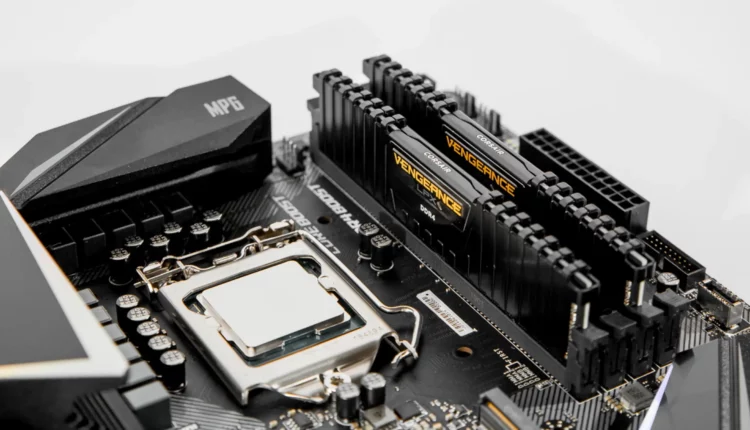©2021 Reporters Post24. All Rights Reserved.
We’ve finally established that 640K of memory isn’t quite enough for anyone, but the correct amount of RAM remains a hot debate topic. RAM isn’t cheap, but the time may finally be here to move on to 32GB of memory.
Professional Users Are Already Beyond 32GB
Before we get into whether the 32GB RAM level is the new sweet spot for regular users, you should know that for professionals working in high-end content creation, or any serious number crunching, 32GB of RAM is firmly in the rearview mirror. It’s not unusual for mobile workstation laptops to ship with 64GB of RAM, and workstation desktops often have CPUs and motherboards with maximum RAM capacities over a terabyte!
For those users, there’s no doubt about how much memory they need. It’s dictated by the applications and the size of the assets or datasets that need to be processed. There has to be enough RAM to keep those powerful CPUs fed with data, or else all that hardware is idling as it waits for (relatively) slow SSD storage to catch up.
The type of user we’re talking about here is the general user. This includes people who do everyday productivity tasks; those who do mainstream video editing, 3D modeling, and music production; and of course, gamers. What’s the case for 32GB of RAM for those who aren’t using a corporate credit card to buy hardware?
Gaming Requirements Are Climbing
For gamers, it’s quickly becoming clear that 32GB of RAM should be in the medium-term future. Star Citizen lists 16GB of RAM as the minimum requirement. Spider-Man Remastered requires 32GB of RAM for its highest settings using ray Tracing. Elden Ring requires 12GB of RAM at a minimum, and we expect next-generation open-world games to have 16GB as the starting point rather than the recommended RAM requirement.
As more and more games start listing recommended RAM requirements above 16GB, it’s clear that those currently playing with 16GB of memory will be under pressure to upgrade sooner than later. This leaves 24GB or 32GB as the next step, depending on your memory channel configuration.
Tabbed Browsing Is a Memory Hog
Not all of us play triple-A video games or spend our time designing sports cars in CAD applications, but you almost certainly use your computer for web browsing at least. Tabbed browsing has made it possible to open dozens or hundreds of web pages as individual tabs. Modern web pages can take up 100s of megabytes each, depending on their content, so the memory footprint adds up rapidly.
On computers with lower amounts of RAM, web pages you aren’t currently using are cached to your hard drive. If that drive is a fast SSD, the impact may not be too drastic, but even then performance can be sluggish as your computer desperately moves data to and from RAM as you browse.
If you’re the type of person with so many tabs open that you can’t even read their titles, splurging on 32GB of RAM can make a noticeable difference to your system’s responsiveness.
More RAM Isn’t Wasted
Modern operating systems such as Windows 11 or macOS are smart enough to use any additional RAM you may have. This is why, after upgrading from 16GB to 32GB of RAM, for example, you’ll see idle RAM usage over the total amount of memory you had before!
Operating systems can pre-load applications or frequently used data so that when you click that button, the responsiveness is much faster. Using RAM that isn’t currently required by a running application as standby memory is usually a good thing.
Multitasking Matters
We’ve discussed the memory requirements of single applications, but a major strength of modern PCs is multitasking. If you want to run multiple applications simultaneously, you need enough RAM to house it all. If you don’t, the computer is forced to shift RAM contents to a drive instead, which is orders of magnitude slower than RAM.
While your tab-heavy browser or your video game might not consume 32GB of RAM by itself, together, they could make short work of it. Modern computers also have oodles of CPU cores . It’s becoming normal to have eight cores; core counts quickly reach silly levels from the mid-range and beyond.
Having many cores means your computer’s CPU can easily do several heavy tasks at once, but if it doesn’t have enough RAM the total number of cores is moot. If you want to keep browsing the web, or watching some YouTube while your project renders out in the background, you need cores and RA M to keep things smooth and responsive.
Who Doesn’t Need 32GB of RAM?
Is it time for everyone to move to 32GB of R AM? At the time of writing, the answer is “yes” for mid to high-end gamers, heavy multitaskers, and anyone looking for the smoothest computing experience possible.
We can’t recommend 8GB of R AM for general computing anymore, at least not on Windows systems. Windows 11 needs a sizeable chunk of that, not leaving that much for even modestly memory-hungry apps. An 8GB Windows system will be usable, at least if it has an SSD, but the clock is ticking as general productivity apps, and web content keeps growing.
16GB of R AM seems to be the most comfortable amount for gamers who don’t mind playing at minimum settings in future.
Similarly, general users who do things like browsing the web with moderate tab counts, doing office or school tasks, and listening to music or watching video don’t have to upgrade above 16GB. Even if you do all of those things at once.
It’s easy to check how much R AM you have on your PC, and if you see a number smaller than 16GB, there’s a good chance an upgrade is in your near future.


